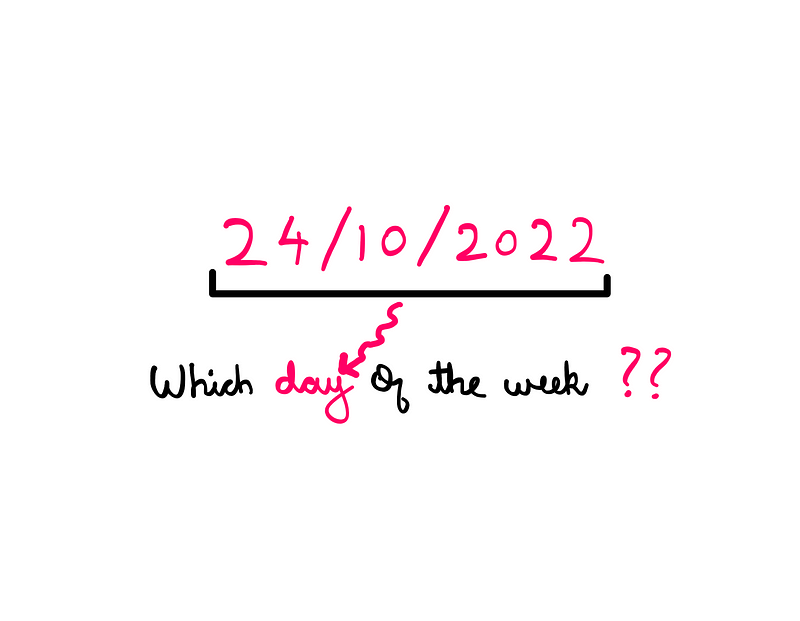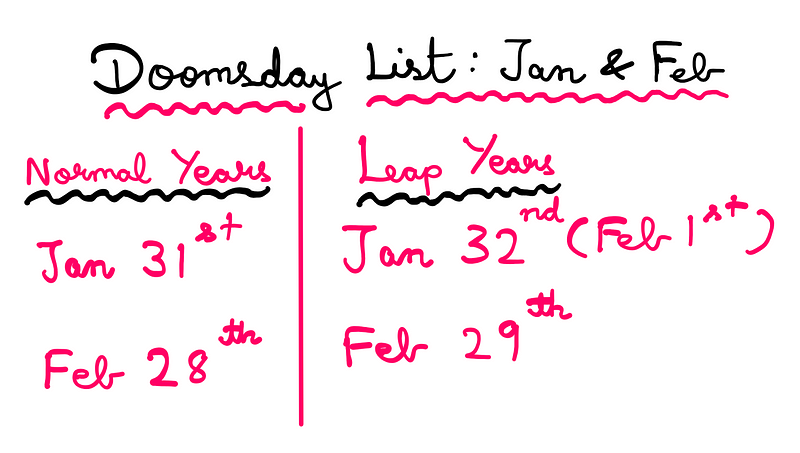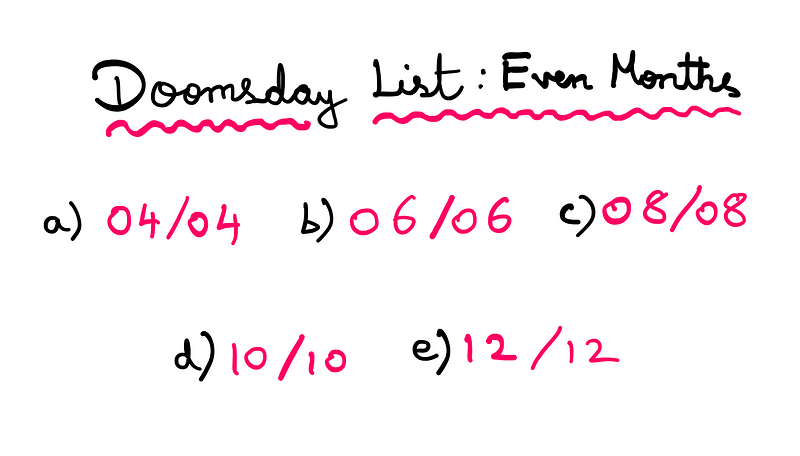Mastering the Art of Calculating the Day of the Week for Any Date
Written on
Chapter 1: Introduction to the Doomsday Algorithm
Have you ever imagined being able to determine the day of the week for any given date? With a touch of mathematics and logic, this can become your reality! However, before diving in, note that mastering this technique requires some initial practice. Once you get the hang of it, you’ll wow your friends with your newfound skills at social gatherings.
The method I will illustrate is known as the Doomsday algorithm, created by John Conway in 1973 (refer to the references section for more details). This algorithm simplifies a rule introduced by Lewis Carroll back in 1872.
The Doomsday algorithm involves three essential steps:
- Determine the Doomsday for the century of the target date.
- Find the Doomsday for the specific year in question.
- Calculate the exact day of the week for the specified date.
Section 1.1: Understanding Doomsdays
To ensure clarity, I will adopt the following date format throughout this article: DD/MM/YYYY (Day/Month/Year). Additionally, I will focus exclusively on the Gregorian calendar (which has been in use since after September 1752).
A Doomsday, as defined by Conway, is the day of the week on which the last day of February falls each year. The algorithm utilizes the fact that several key dates within each month align with this Doomsday. In essence, if we know the weekday for the last day of February, we can derive the weekday for numerous other dates throughout that year through basic arithmetic.
But how can we ascertain which weekday the last day of February falls on? Before we delve into that, let’s outline the various Doomsdays throughout the year.
Section 1.2: Doomsdays Throughout the Year
Let’s start with January and February:

The notion of January 32nd doesn’t exist (it’s actually February 1st), but Conway recommends considering it this way for easier recall.
Next, we examine the even months of the year, which are relatively straightforward:

The odd months can be a bit more complex, yet they adhere to a simple principle. For any odd month numbered ‘n’, the Doomsday is determined by n +/- 4. For odd months with 31 days, the Doomsday is n + 4, while for the 30-day odd months (September and November), it is n - 4.
In summary, here’s a condensed Doomsday list to memorize:

With this list in mind, you can always add or subtract multiples of 7 to find other Doomsdays for the year.
Chapter 2: Example Calculation
Let’s say you want to find the day of the week for the date: 30/10/2022. If we know that Doomsdays in 2022 fall on Mondays, we can deduce that 10/10/2022 also lands on a Monday since it is a Doomsday. By adding 14 days, we find that 24/10/2022 is the next Doomsday. Adding 6 to this gives us Sunday (Monday + 6) as the weekday for 30/10/2022.
Now, the question arises: how do we determine the Doomsday for 2022? Let’s explore that next.
Section 2.1: Calculating Doomsday for a Century
To begin, remember that the years 0, 400, 800, 1200, 1600, etc., are all Tuesdays. Essentially, the Doomsdays for any year that is a multiple of 400 are on Tuesdays. For every subsequent century after a multiple of 400, the Doomsday shifts back by 2 days.
For example, since 2000 is a multiple of 400, we conclude that the Doomsday for that century is Tuesday. However, 1900 is 300 years (or 3 centuries) after 1600. Hence, we subtract 6 days from Tuesday (2*3) to find that the Doomsday for 1900 is Wednesday.
So far, we can compute the Doomsday for any given century. But how do we determine the years in between?
Section 2.2: Calculating Doomsday for Any Year Within a Century
Once we have the Doomsday for a century, we can note that each ordinary year advances the Doomsday by 1 day, while each leap year shifts it by 2 days. We can break each century into groups of 12 years.
For instance, if we’re interested in the Doomsday for 2012, we know that the Doomsday for 2000 is Tuesday. In any set of 12 years, there are 3 leap years, so the Doomsday shifts by (12 + 3) = 15 days, which translates to adding 1 day to Tuesday, making Wednesday the Doomsday for 2012.
Chapter 3: Calculating the Day of the Week for Any Date
We are now ready to calculate the day of the week for any date. Let’s choose a future date: 20/06/3075. Yes, this algorithm works for dates far ahead!
First, compute the Doomsday for the century. Since 3000 is two centuries after 2800 (the previous multiple of 400), and we know 2800’s Doomsday is Tuesday, we shift Tuesday back by 4 days to find Friday as the Doomsday for 3000.
Next, we calculate the Doomsday for 3075. We note that 3075 is 75 years, or (12 * 6) + 3, beyond 3000. Therefore, we add (6 + 3) days to Friday. Since there are no leap years from 3072 to 3075, we can calculate it as follows:
Doomsday for 3075 = Friday + (6 + 3) + 0
= Friday + 9
= Friday + 7 + 2
= Friday + 2
= Sunday!
Thus, 06/06/3075 falls on a Sunday (a Doomsday!). Consequently, since 20/06/3075 is 14 days later, it also lands on a Sunday.
In summary, here’s a quick ten-step process to employ the Doomsday algorithm at any social event:
- Gather an audience.
- Invite someone to choose a random date.
- Compute the Doomsday for the century mentally.
- Add the number of complete dozen years, the remainder, and the number of fours in the remainder (all in your head). This gives you the Doomsday for that year.
- Use your memorized Doomsday list to determine the day of the week for the specified date.
- Ask someone to verify your answer.
- Enjoy the amazed reactions from the crowd.
- With a confident demeanor, challenge someone else to provide another random date.
- Repeat the procedure.
- For added excitement, encourage the crowd to select a date far into the future!
In this video, learn how to figure out the day of the week for any date, utilizing techniques that will amaze your friends!
This video explains how to calculate the day of the week from the date in seconds, showcasing mental math strategies for solving calendar problems.
Credit and reference: J.H. Conway (recreational science article — page 28).
I trust you found this article both fascinating and informative. If you wish to support my work as an author, consider clapping, following, and subscribing.
For further reading that might pique your interest: How To Mentally Square Any Number Ending in 5? and What Is So Special About 69!?